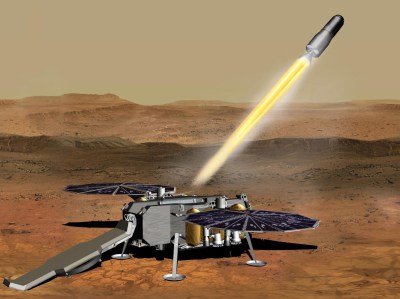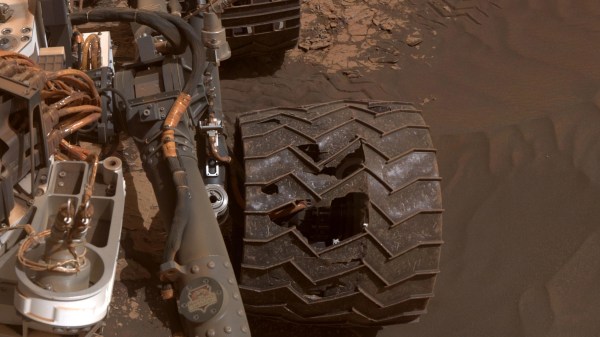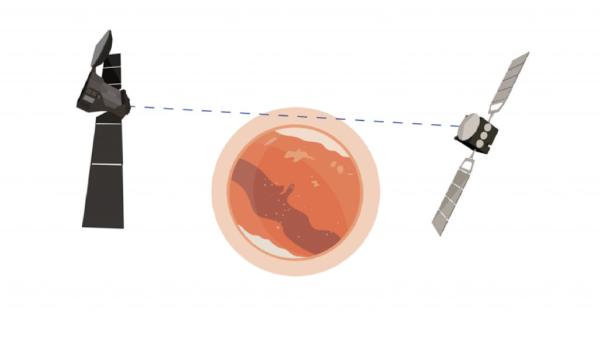As if the war in Ukraine weren’t bad enough right here on Earth, it threatens knock-on effects that could be felt as far away as Mars. One victim of the deteriorating relationships between nations is the next phase of the ExoMars project, a joint ESA-Roscosmos mission that includes the Rosalind Franklin rover. The long-delayed mission was most recently set for launch in October 2022, but the ESA says that hitting the narrow launch window is now “very unlikely.” That’s a shame, since the orbital dynamics of Earth and Mars will mean that it’ll be 2024 before another Hohmann Transfer window opens. There are also going to be repercussions throughout the launch industry due to Russia pulling the Soyuz launch team out of the ESA’s spaceport in Guiana. And things have to be mighty tense aboard the ISS right about now, since the station requires periodic orbital boosting with Russian Progress rockets.
mars108 Articles
Martian Wheel Control Algorithms Gain Traction
Imagine the scene: You’re puttering along in your vehicle when, at least an hour from the nearest help, one of your tires starts losing air. Not to worry! You’ve got a spare tire along with the tools and knowhow to change it. And if that fails, you can call roadside assistance. But what if your car isn’t a car, has metal wheels for which no spares are available, and the nearest help is 200 million miles away? You just might be a Jet Propulsion Laboratory Engineer on the Curiosity Mars Rover mission, who in 2017 was charged with creating a new driving algorithm designed to extend the life of the wheels.

You could say that the Curiosity Mars rover is the ultimate off-road vehicle, and as such it has to deal with conditions that are in some ways not that different from some locations here on Earth. Earth bound rock crawlers use long travel suspensions, specialized drivetrains, and locking differentials to keep the tires on the ground and prevent a loss of traction.
On Mars, sand and rocks dominate the landscape, and a rover must navigate around the worst of it. It’s inevitable that, just like a terrestrial off-roader, the Mars rovers will spin a tire now and then when a wheel loses traction. The Mars rovers also have a specialized drivetrain and long travel suspensions. They don’t employ differentials, though, so how are they to prevent a loss of traction and the damaging wheel spin that ensues? This where the aforementioned traction control algorithm comes in.
By controlling the rotation of the wheels with less traction, they can still contribute to the motion of the vehicle while avoiding rock rash. Be sure to check out the excellent article at JPL’s website for a full explanation of their methodology and the added benefits of uploading new traction control algorithms from 200 million miles away! No doubt the Perseverance Mars rover has also benefited from this research.
But why should NASA get to have all the fun? You can join them by 3d printing your own Mars rover and just maybe some Power Wheels derived traction control. What fun!
NASA Taps Lockheed To Bring Back A Piece Of Mars
Since NASA’s Mariner spacecraft made the first up-close observations of Mars in 1964, humanity has lobbed a long line of orbiters, landers, and rovers towards the Red Planet. Of course, it hasn’t all been smooth sailing. History, to say nothing of the planet’s surface, is littered with Martian missions that didn’t quite make the grade. But we’ve steadily been getting better, and have even started to push the envelope of what’s possible with interplanetary robotics through ambitious craft like the Ingenuity helicopter.
Yet, after nearly 60 years of studying our frigid neighbor, all we have to show for our work boils down to so many 1s and 0s. That’s not to say the data we’ve collected, both from orbit and on the surface, hasn’t been extremely valuable. But scientists on Earth could do more with a single Martian rock than any robotic rover could ever hope to accomplish. Even still, not so much as a grain of sand has ever been returned from the planet’s dusty surface.
But if everything goes according to plan, that’s about to change. Within the next decade, NASA and the European Space Agency (ESA) hope to bring the first samples of Martian rocks, soil, and atmospheric gases back to Earth using a series of robotic vehicles. While it’s still unclear when terrestrial scientists should expect delivery of this interplanetary bounty, the first stage of the program is already well underway. The Perseverance rover has started collecting samples and storing them in special tubes for their eventual trip back to Earth. By 2028, another rover will be deployed to collect these samples and load them into a miniature rocket for their trip to space.

Just last week NASA decided to award the nearly $200 million contract to build that rocket, known officially as the Mars Ascent Vehicle (MAV), to aerospace giant Lockheed Martin. The MAV will not only make history as the first rocket to lift off from a celestial body other than the Earth, but it’s arguably the most critical component of the sample return mission; as any failure during launch will mean the irrevocable loss of all the samples painstakingly recovered by Perseverance over the previous seven years.
To say this mission constitutes a considerable technical challenge would be an understatement. Not only has humanity never flown a rocket on another planet, but we’ve never even attempted it. No matter what the outcome, once the MAV points its nose to the sky and lights its engines, history is going to be made. But while it will be the first vehicle to make the attempt, engineers and scientists have been floating plans for a potential Martian sample return mission for decades. Continue reading “NASA Taps Lockheed To Bring Back A Piece Of Mars”
SHERLOC And The Search For Life On Mars
Humanity has been wondering about whether life exists beyond our little backwater planet for so long that we’ve developed a kind of cultural bias as to how the answer to this central question will be revealed. Most of us probably imagine that NASA or some other space agency will schedule a press conference, an assembled panel of scientific luminaries will announce the findings, and newspapers around the world will blare “WE ARE NOT ALONE!” headlines. We’ve all seen that movie before, so that’s the way it has to be, right?
Probably not. Short of an improbable event like an alien spacecraft landing while a Google Street View car was driving by or receiving an unambiguously intelligent radio message from the stars, the conclusion that life exists now or once did outside our particular gravity well is likely to be reached in a piecewise process, an accretion of evidence built up over a long time until on balance, the only reasonable conclusion is that we are not alone. And that’s exactly what the announcement at the end of last year that the Mars rover Perseverance had discovered evidence of organic molecules in the rocks of Jezero crater was — another piece of the puzzle, and another step toward answering the fundamental question of the uniqueness of life.
Discovering organic molecules on Mars is far from proof that life once existed there. But it’s a step on the way, as well as a great excuse to look into the scientific principles and engineering of the instruments that made this discovery possible — the whimsically named SHERLOC and WATSON.
Hackaday Links: December 26, 2021
At the time of this writing, the James Webb Space Telescope was perched upon its ride to space, ready for its much-delayed launch from the ESA spaceport in French Guiana. The $10 billion space observatory suffered one final delay (knocks on wood) when predictions of high winds aloft pushed it back from a Christmas Eve launch to a Christmas Day departure, at 12:20 UTC. Given the exigencies of the day, we doubt we’ll be able to watch the launch live — then again, past experience indicates we’ll still be wrapping presents at 4:20 PST. Either way, here’s hoping that everything comes off without a hitch, and that astronomers get the present they’ve been waiting many, many Christmases for.
In other space news, things are getting really interesting on Mars. The ESA announced that their ExoMars Trace Gas Orbiter has detected signs of water in the Valles Marineris. The satellite found a large area of increased hydrogen concentration in the top meter of Martian soil; the assumption is that the hydrogen comes from water, meaning that as much as 40% of the material in the region scanned may be water. If so, that’s a huge find, as we thought most of Mars’ water was locked in the polar regions. The Mariner Valley stretches more than 4,000 km just below the equator, and so may prove to be an important resource for future explorers.
Meanwhile, in Jezero crater, Perseverance has decided to upstage its rotorcraft sidekick for a change by finding signs of organic molecules on Mars. It’s not the first time organic compounds have been found — Perseverance’s cousin Curiosity found some too, ESA’s Mars Express mission spotted methane from on high, and then there were the equivocal but intriguing results from the Viking missions in the 1970s. But the latest evidence is really great news for the scientists who picked Jezero crater as a likely place to search for signs of past life on Mars. The organics found are not proof of life by any means, as there are many ways to make organic molecules abiotically. But then again, if you’re going to find evidence of life on Mars, you’ve got to start with detecting organics.
Back on Earth, getting your laptop stolen would be bad enough. But what if it got yoinked while it was unlocked? Depending on who you are and what you do with that machine, it could be a death sentence. That’s where BusKill could come in handy. It’s a hardware-software approach to securing a laptop when it — or you — suddenly goes missing. A dongle with a breakaway magnetic lanyard gets plugged into a USB port, and the other end of the lanyard gets attached to your person. If you get separated from your machine, the dongle sends customizable commands to either lock the screen or, for the sufficiently paranoid, nuke the hard drive. The designs are all up on GitHub, so check it out and think about what else this could be useful for.
If you like the look of low-poly models but hate the work involved in making them, our friend and Hack Chat alumnus Andrew Sink came up with a solution: an online 3D low-poly generator. The tool is pretty neat; it uses three.js and runs completely in-browser. All you have to do is upload an STL file and set sliders to get rid of as many triangles as you want. Great stuff, and fun to play with even if you don’t need to decimate your polygons.
And finally, what have you done with your oscilloscope for the last three years? Most of us can’t answer that except in the vaguest of terms, but then there’s DrTune, who took three years’ worth of screencaps from this Rigol DS1054z and strung them together into a 60-second movie. He swears he didn’t purposely sync the video to the soundtrack, which is “Flight of the Bumblebee” by Rimsky-Korsakov, but in some places it’s just perfect. See if you can guess what DrTune has been working on by watching the waveforms fly by. And watch for Easter eggs.
Hackaday Links: December 12, 2021
It looks as though the Mars Ingenuity flight team is starting to press the edge of the envelope a bit. The tiny rotorcraft, already 280-something sols into a mission that was only supposed to last for about 30 sols, is taking riskier flights than ever before, and things got particularly spicy during flight number 17 this past week. The flight was a simple up-over-and-down repositioning of the aircraft, but during the last few meters of descent at its landing zone, Ingenuity dipped behind a small hill and lost line-of-sight contact with Perseverance. Without the 900-MHz telemetry link to the rover, operators were initially unable to find out whether the chopper had stuck the landing, as it had on its previous 16 flights. Thankfully, Perseverance picked up a blip of data packets about 15 minutes after landing that indicated the helicopter’s battery was charging, which wouldn’t be possible if the craft were on its side. But that’s it as far as flight data, at least until they can do something about the LOS problem. Whether that involves another flight to pop up above the hill, or perhaps even repositioning the rover, remains to be decided.
Thinking up strong passwords that are memorable enough to type when they’re needed is never easy, and probably contributes more to the widespread use of “P@$$w0rD123” and the like than just about anything. But we got a tip on a method the musically inclined might find useful — generating passwords using music theory. It uses standard notation for chords to come up with a long, seemingly random set of characters, like “DMaj7|Fsus2|G#9”. It’s pretty brilliant, especially if you’ve got the musical skills to know what that would sound like when played — the rest of us can click here to find out. But since we can’t carry a tune in a bucket, we’ll just stick with the “correct horse battery staple” method.
Looks like you can only light so many roofs on fire before somebody starts to take an interest in what’s going on. At least that seems to be the case with Tesla, which is now under investigation by the US Security and Exchanges Commission for not keeping its shareholders and the public looped in on all those pesky solar array fires it was having back in the day. The investigation stems from a 2019 whistleblower complaint by engineer Steven Henkes, who claims he was fired by Tesla after pointing out that it really would be best not to light their customers’ buildings on fire with poorly installed solar arrays. It’s interesting that the current investigation has nothing to do with the engineering aspects of these fires, but rather the financial implications of disclosure. We discussed some of those problems before, which includes dodgy installation practices and seems to focus on improperly torqued MC4 connectors.
Staying with the Tesla theme, it looks like the Cybertruck is going to initially show up as a four-motor variant. The silly-looking vehicle is also supposed to sport four-wheel steering, which will apparently make it possible to drive diagonally. We’ve been behind the wheel for nearly four decades at this point and can count on no hands the number of times diagonal driving would have helped, and while there might be an edge case we haven’t bumped into yet, we suspect this is more about keeping up with the competition than truly driving innovation. It seems like if they were really serious about actually shipping a product, they’d work on the Cybertruck windshield wiper problem first.
And finally, as I’m sure you’re all aware by now, our longtime boss Mike Szczys is moving on to greener pastures. I have to say the news came as a bit of shock to me, since I’ve worked for Mike for over six years now. In that time, he has put me in the enviable position of having a boss I actually like, which has literally never happened to me before. I just thought I’d take the chance to say how much I appreciate him rolling the dice on me back in 2015 and giving me a chance to actually write for a living. Thanks, Mike, and best of luck with the new gig!
Two Mars Orbiters Chatted For Atmospheric Science
Mission extensions for interplanetary robot explorers are usually continuations of their primary mission. But sometimes the hardware already on board are put to novel uses. European Space Agency has started using radio equipment on board two Mars orbiters to probe the Martian atmosphere.
The scientific basis is straightforward: radio signals are affected by whatever they had traveled through. When transmitting data, such effects are noises to be minimized. But we can also leverage it for atmospheric science here on Earth. ESA applied the same concept at Mars: by transmitting a known signal from one Mars orbiter to another, changes in the received signal tells scientists something about the Martian atmosphere between them.
So the theory sounds good, but the engineering implementation took some work. Most radio equipment on board ESA’s orbiters were not designed to talk to each other. In fact they were deliberately different to minimize interference. However, both Mars Express and Trace Gas Orbiter were designed to act as data relays for surface probes, and not just the one they each carried to Mars. Thus their related radio gear were flexible enough to be adapted to this experiment.
These two machines launched over a decade apart. Yet they could now communicate with each other in Mars orbit using radios originally designed for talking to the surface. In the near future such chatter will probably be limited, as Trace Gas Orbiter is still in the middle of its primary mission. But this success lets ESA think about how much further to push the idea in the future. In the meantime Mars Express will continue its observation of Mars, doing things like giving us context on Perseverance rover landing.















